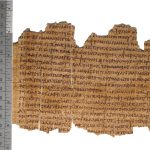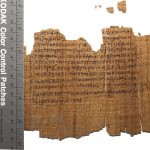| Artefact ID | 38 |
| TM ID | TM 749338 |
| Findspot (DEChriM ID) | - () | Class | Textual |
| Material | Papyrus |
| Writing medium | Sheet/roll |
| Text content | Literary |
| Language | Coptic |
| Description | P.Monts.Roca inv. 14 The Montserrat roll is a papyrus roll containing a Sahidic Coptic translation of a large part of the Letter to Dracontius of Athanasius. The letter was sent from the Patriarchate of Alexandria along with the Festal letter of 354 (Torallas Tovar 2018, 22, 28) and distributed throughout the country. Dracontius was a famous Nitrian monk ("father of the monks" of Nitria) who had been consacrated bishop of Hermoupolis Parva the same year (Martin 1996, 467). Refusing the role, he fled. Athanasius' letter targets the monastic milieu, criticising the monks supposed to have influenced Dracontius' decision to flee. But, before all else, it urges Dracontius to accept the nomination. The historical context of the letter is that of the period prior to the Easter of 354, dominated by Arian turmoil and fear of persecution. In 353, Athanasius had, indeed, been condamned at the pro-Arian Council or Arles, following which an Athanasian delegation led by Serapion of Thmouis and Ammonios of Pachnemounis tried in mai 353 to appeal the synodal decision to emperor Contantius, in Milan (Martin 1996, 467, n. 56). The apprehensions expressed in the letter will materialise two years later, in 356, when Athanasius will flee Alexandria for his "third exile", and Dracontius, like many other Athanasian bishops, will be expelled from his see. The roll is broken at the beginning but still preserves 6 columns (5 on recto, along the fibres; 1 on verso across the fibres). It is the earliest known evidence for this letter, pre-dating the earliest surviving Greek codex by six centuries (Torallas Tovar 2018, 22, 31). |
| Selection criteria | Literary genre (Theological), Mention of Christian cult officials/institutions, Mention of Christian individuals/communities, Coptic language |
| Date from | 300 |
| Date to | 399 |
| Dating criteria | "The paleography of [P. Monts. Roca inv. 14] places it at least in the same graphic environment as the codices from the southern area in the fourth century, with the closest example found in Bodmer XXI." (Torallas Tovar 2018, 24). |
| Absolute/relative date | Relative date |
| Archaeological context | Precise origins unknown. It could have originally belonged to the Bodmer library, which might have originated from Panopolis, which could explain certain Akmimic traits present in the text (Torallas Tovar 2018, 26-27). |
| Accession number | Montserrat, Abadia Roca inv. no. 14 |


 Json data
Json data





